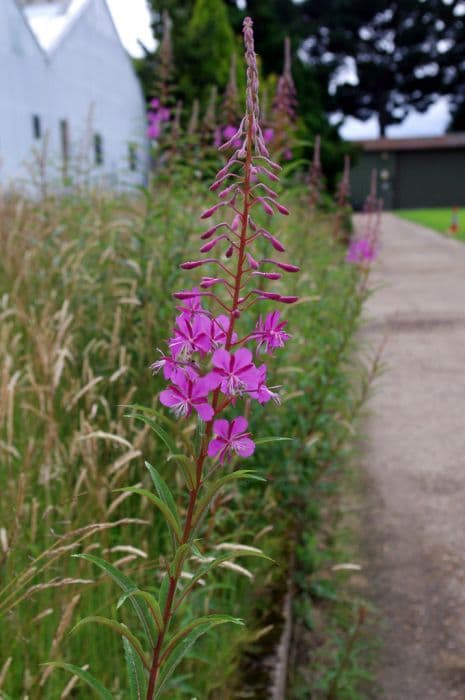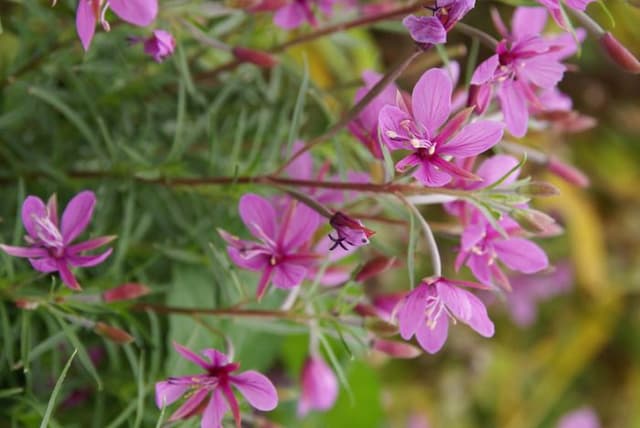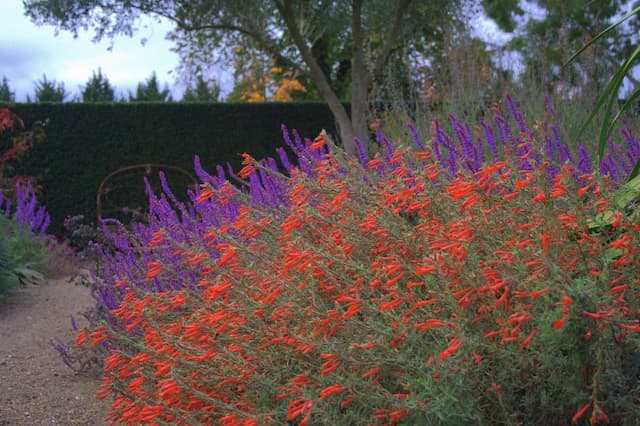Fireweed Chamaenerion angustifolium

ABOUT
Chamaenerion angustifolium, commonly known as fireweed, is a flowering plant marked by its tall, erect posture and vibrant floral display. It is characterized by lance-shaped leaves that are arranged spirally on its stem, providing a dense, green backdrop to its colorful blooms. The foliage may exhibit a fine, slightly hairy texture, contributing to the plant's overall delicate appearance. As for the flowers, they are the highlight of fireweed, presenting in striking shades of pink and magenta. These blooms are composed of four rounded petals that form a conspicuous, symmetrical pattern, making the plant highly attractive to pollinators. Each individual flower is arranged on a long, slender spike that creates a spire-like effect, aiding in the plant's visibility in its natural habitat. This floral spire hosts a multitude of blooms that open progressively from bottom to top, offering a prolonged and showy flowering period. After the flowering season, fireweed produces elongated, capsule-like seed pods that split open to release numerous tiny seeds equipped with silken hairs that facilitate wind dispersal. Overall, the aesthetic appeal of fireweed lies in its elegant structure, vivid blossoms, and its ability to bring a splash of color to the landscapes in which it thrives.
About this plant
 Names
NamesFamily
Onagraceae.
Synonyms
Fireweed, Great Willowherb, Rosebay Willowherb, Blooming Sally, French Willow, Wicopy.
Common names
Chamerion angustifolium, Chamaenerion spicatum, Chamerion spicatum, Epilobium angustifolium, Epilobium spicatum.
 Toxicity
ToxicityTo humans
The common name for Chamaenerion angustifolium is fireweed. Fireweed is not typically considered toxic to humans and is actually edible when young and properly prepared. However, as with any plant, individual allergies or sensitivity may cause adverse reactions in some people. There are no well-documented toxic effects from ingesting fireweed, and it is not known to contain any significant toxins that would cause poisoning symptoms in humans.
To pets
The common name for Chamaenerion angustifolium is fireweed. Fireweed is not generally considered toxic to pets either, including dogs and cats. There are no significant reports of toxicity or poisoning in pets from consuming fireweed. However, as with humans, individual animals might have different sensitivities, and feeding plants to pets should be done with caution and ideally only under veterinary guidance.
 Characteristics
CharacteristicsLife cycle
Perennials
Foliage type
Deciduous
Color of leaves
Green
Flower color
Pink
Height
3-5 feet (0.9-1.5 meters)
Spread
1-3 feet (0.3-0.9 meters)
Plant type
Herb
Hardiness zones
2-9
Native area
Northern Hemisphere
Benefits
 General Benefits
General Benefits- Wildlife habitat: Fireweed provides food and habitat for a variety of wildlife including insects, birds, and mammals.
- Erosion control: The plant's robust root system helps stabilize soil and prevent erosion, particularly after forest fires or human disturbances.
- Restoration species: Often one of the first plants to colonize disturbed areas, fireweed can play a crucial role in natural regeneration and restoration efforts.
- Ornamental use: With its striking tall spikes of pink and purple flowers, fireweed is frequently used in gardens and landscaping for aesthetic purposes.
- Pollinator support: The plant is a significant nectar source for bees, butterflies, and other pollinators, which are essential for ecosystem health and agriculture.
- Food source: Young shoots and leaves of fireweed can be consumed by humans as a vegetable or in teas, providing a source of nutrients when foraged responsibly.
- Ecological indicator: Its presence can indicate certain soil and environmental conditions and help in ecological monitoring and studies.
- Dye production: The roots and other parts of fireweed have been used traditionally to produce natural dyes for textiles.
- Cultural significance: Indigenous peoples have historically used fireweed for various purposes, making it part of the cultural heritage in some regions.
 Medical Properties
Medical Properties- Anti-inflammatory: Chamaenerion angustifolium, commonly known as fireweed, has been traditionally used for its anti-inflammatory properties.
- Antiseptic: The plant has been used for its antiseptic effects, particularly in skin care and wound treatment.
- Astringent: Fireweed contains astringent properties which can help toning the skin and mucous membranes.
- Demulcent: Its mucilaginous content provides a soothing effect on irritated tissues, particularly in the digestive tract.
- Diuretic: The plant has been used to promote urine production and may support kidney health.
- Laxative: There is historical use of fireweed as a mild laxative, helping to relieve constipation.
- Sedative: Some traditional uses include the ingestion of the plant to help with sleep disorders and anxiety due to its sedative effects.
 Air-purifying Qualities
Air-purifying QualitiesThis plant is not specifically known for air purifying qualities.
 Other Uses
Other Uses- Fireweed fibers have been used historically to make thread for weaving, due to their strength and light weight.
- The silky fluff from fireweed seeds is utilized as a stuffing for pillows or insulation, as it has good thermal properties.
- The plant's ashes, rich in potassium, were once used as a salt substitute or as a fertilizer in agriculture.
- Fireweed is sometimes used as an indicator species in ecological studies because it flourishes in disturbed soils, providing insights into soil health and succession.
- In beekeeping, fireweed is valued for its long blooming period, which provides a consistent nectar source for bees to produce honey.
- The dried leaves of fireweed can be fermented to create Ivan Chai, a traditional Russian herbal tea.
- Fireweed pith, which is the central tissue in the stem, can be used in flower arrangements to support delicate stems or in art projects.
- The plant has been used for dyeing fabric, yielding a range of colors from green to yellow depending on the mordant used.
- Fireweed can be used to create a natural red or purple pigment for use in cosmetics or as food coloring.
- In culinary applications, young fireweed shoots and leaves are edible, often prepared like asparagus or used in salads and side dishes.
Interesting Facts
 Feng Shui
Feng ShuiThe fireweed is not used in Feng Shui practice.
 Zodiac Sign Compitability
Zodiac Sign CompitabilityThe fireweed is not used in astrology practice.
 Plant Symbolism
Plant Symbolism- Fireweed - Rebirth and Renewal: As one of the first plants to grow after a fire, fireweed symbolizes new growth and the ability to overcome adversity.
- Fireweed - Healing: Known for its medicinal properties, fireweed represents healing of both the body and the spirit.
- Fireweed - Resilience: The plant's capacity to thrive in damaged landscapes embodies the quality of resilience.
- Fireweed - Transformation: The lifecycle of fireweed, from its desolation-defying growth to becoming tall, flowering stalks, is emblematic of transformation and change.
 Water
WaterFireweed, as Chamaenerion angustifolium is commonly known, prefers consistent moisture, especially during its growing season. Water the plant when the top inch of soil feels dry to the touch, which may be roughly once a week, depending on climate conditions. A deep watering is preferable to encourage root growth, so aim to provide about 1-2 gallons of water per plant, per watering session, allowing the moisture to penetrate deeply into the soil. During the winter dormancy period, reduce watering significantly, but do not allow the soil to become completely dry for prolonged periods.
 Light
LightFireweed thrives in full to partial sunlight. The ideal location for this plant is a spot where it can receive at least six hours of direct sunlight daily. If grown indoors, place it near a south-facing window to ensure it gets ample light. However, in extremely hot climates, a bit of afternoon shade can be beneficial to prevent scorching.
 Temperature
TemperatureFireweed is hardy and can survive in a broad range of temperatures, but it grows best when the ambient temperature is between 60°F and 70°F. It can endure minimum temperatures down to around 43°F and maximum temperatures up to approximately 86°F. It's essential to protect fireweed from frost, which can damage the plant.
 Pruning
PruningPruning fireweed is usually done to maintain its shape and remove dead or damaged stems. It's best to prune in the early spring before new growth starts. Cut back any old stems to ground level and thin out crowded areas to ensure good air circulation. Pruning is not required frequently, once a year is typically enough.
 Cleaning
CleaningAs needed
 Soil
SoilFireweed prefers a well-draining soil mix with a slightly acidic to neutral pH of around 5.5 to 7.0. A mix containing loamy soil, peat, and perlite or sand can provide the ideal growing conditions, ensuring adequate drainage and aeration. Regular garden soil amended with organic matter can also be suitable.
 Repotting
RepottingFireweed rarely needs repotting as it often grows in the wild and spreads through rhizomes and seeds. In a garden setting, dividing the plant every few years can rejuvenate its growth.
 Humidity & Misting
Humidity & MistingFireweed thrives in average humidity levels reflective of its natural habitat, which include open meadows and forest clearings. It does not require any special humidity adjustments when grown outdoors.
 Suitable locations
Suitable locationsIndoor
Ensure ample light, moist soil, and good airflow for indoor Fireweed.
Outdoor
Plant in well-drained soil, full sun to partial shade, naturalize easily.
Hardiness zone
2-9 USDA
 Life cycle
Life cycleFireweed (Chamaenerion angustifolium) begins its life cycle as a seed, which, once dispersed by wind, germinates in open, disturbed sites ideally created by events like fire. As a hardy perennial, upon germination, it quickly establishes a rosette of leaves at the soil surface, and a deep taproot. Following the juvenile rosette stage, during its first or second year, it develops a flowering stalk that can reach up to 2 meters in height, producing showy purple to pink flowers that are pollinated by insects, particularly bees. After pollination, the plant produces seed capsules filled with numerous small seeds, equipped with silky hairs that aid in wind dispersal. Fireweed can also reproduce vegetatively through its rhizome system, allowing it to spread and colonize new areas rapidly. Finally, after setting seed, the plant senesces; however, the roots and rhizomes can survive and send up new growth the following season.
 Propogation
PropogationPropogation time
Spring to Summer
Chamaenerion angustifolium, commonly known as fireweed, can be propagated most popularly through seeds. The best time to sow fireweed seeds is in spring after the last frost when the soil temperature has started to warm up. To propagate, seeds should be scattered on the surface of a well-draining soil mix and lightly pressed into the substrate but not covered as they require light to germinate. Consistently moist conditions need to be maintained until the seeds germinate, which usually occurs within a couple of weeks to two months. Seedlings can then be carefully transplanted to their final growing positions once they've grown sufficiently to handle safely, typically when they've developed a couple of sets of true leaves.









